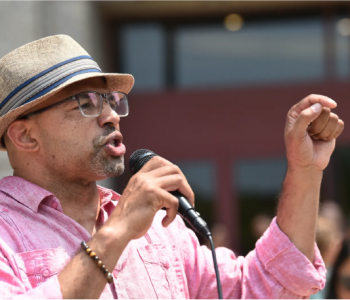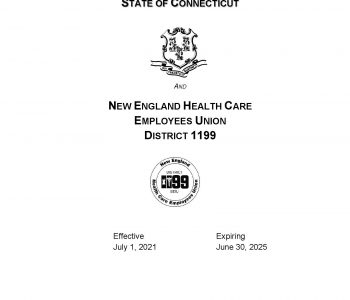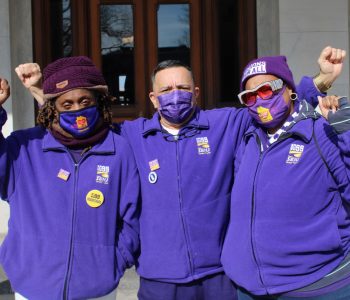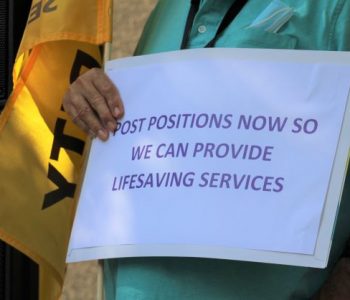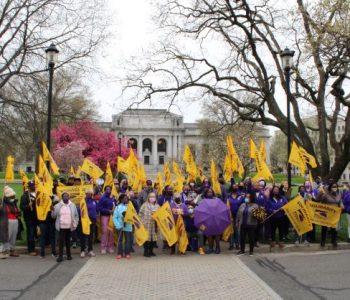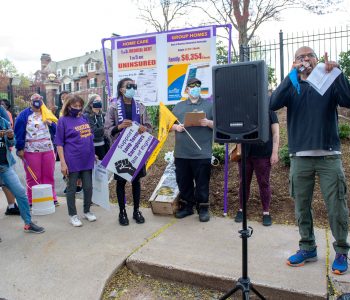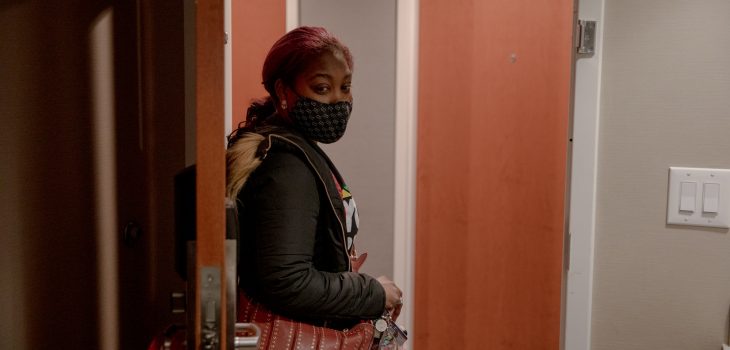 Connecticut
Connecticut
One hundred and forty days have passed since Denitra Pearson lost her job caring for the elderly in their homes. Forty-two days have passed since she, her husband, and children lost all their belongings after a fire engulfed their house on a snowy winter night.
They’re now living in a hotel.
Fast food and non-perishables are their primary diet. There’s no kitchen in their small living quarters.
Although a Section 8 housing voucher ensures they can pay rent, they can’t find an apartment within their budget that isn’t infested with mice or mold.
Pearson, a New Haven mother of six, has an associate’s degree and two job certificates but only one of the dozens of applications she’s filled out has led anywhere, landing her another low-wage job at a local clinic vaccinating people against COVID-19. Her husband, who was a chef at a nearby university before the pandemic disrupted the college campus, is still looking for work.
“I don’t wish that on my worst enemy, like ever. This is insane. Hotel [living] is not the life,” Pearson said.
Pearson — and many other low-wage families — are waiting for the economic recovery to reach them.
Of the nearly 300,000 jobs lost almost overnight when the pandemic hit Connecticut last March, about 58% have returned, a figure that has not seen any appreciable improvement since September, just as the number of unemployed remains largely unchanged.
The brunt of this downturn, however, is primarily falling on certain families and neighborhoods.
While unemployment rates for Connecticut workers who were making more than $60,000 a year before the pandemic have almost entirely rebounded, employment among those who were making low-wages was still down 28% through the first week of February. Unemployment claims are similarly lopsided toward poor residents.
https://kpananjady.github.io/my-portfolio2/wages.htmlSource: CT Department of Labor. Initial claims — or applications for unemployment — do not include claims that have been reopened and are not necessarily granted. Claims do not include self-employed individuals who are unemployed or those not covered by the unemployment system, such as federal workers. Data for those not reporting wages omitted. Credit: Kasturi Pananjady
Communities that were already struggling with poverty before the pandemic were hit particularly hard when the jobs vanished. While the federal stimulus dollars and expanded unemployment benefits have helped sustain many households and small businesses in the short-term, more people than ever are relying on food pantries, racking up debt, withdrawing money from their retirement, or putting off paying rent to get them through.
“What this pandemic has done has just really exposed and magnified some of the issues that we already knew were there. But now, you can’t ignore it. You can’t ignore businesses closing at alarming rates. You can’t ignore students that are off track,” said AJ Johnson, the pastor of the Urban Hope Refugee Church in Hartford’s North End and a community organizer with the Center for Leadership and Justice. “It just has exposed and magnified things in a way that the world can see it.”
That attention is fading, he worries.
“A year later, people are starting to move and start to get their lives back together and working has become a real thing — and so it becomes a distant thing of the past,” he said. “I’m afraid that we might miss a moment — where when we say ‘Black Lives Matter’ and really matter — I’m afraid that we are driving by that moment to do something really substantial.”
In an effort to keep the spotlight on this issue, numerous grass roots groups and labor organizations have joined together to host rallies and voice displeasure with the state’s uneven recovery.
“Poor people demand justice” proclaimed a 4 foot tall sign held by two New Haven moms outside the Governor’s Residence during a Feb. 20 rally hosted by the “Recovery for All” coalition.
The same coalition last week hosted a rally in Danbury. There, a teacher of Spanish speaking children shared the story of how the mother of one of her students recently showed up on her doorstep, out of work, and attempting to sell jewelry so she could buy food.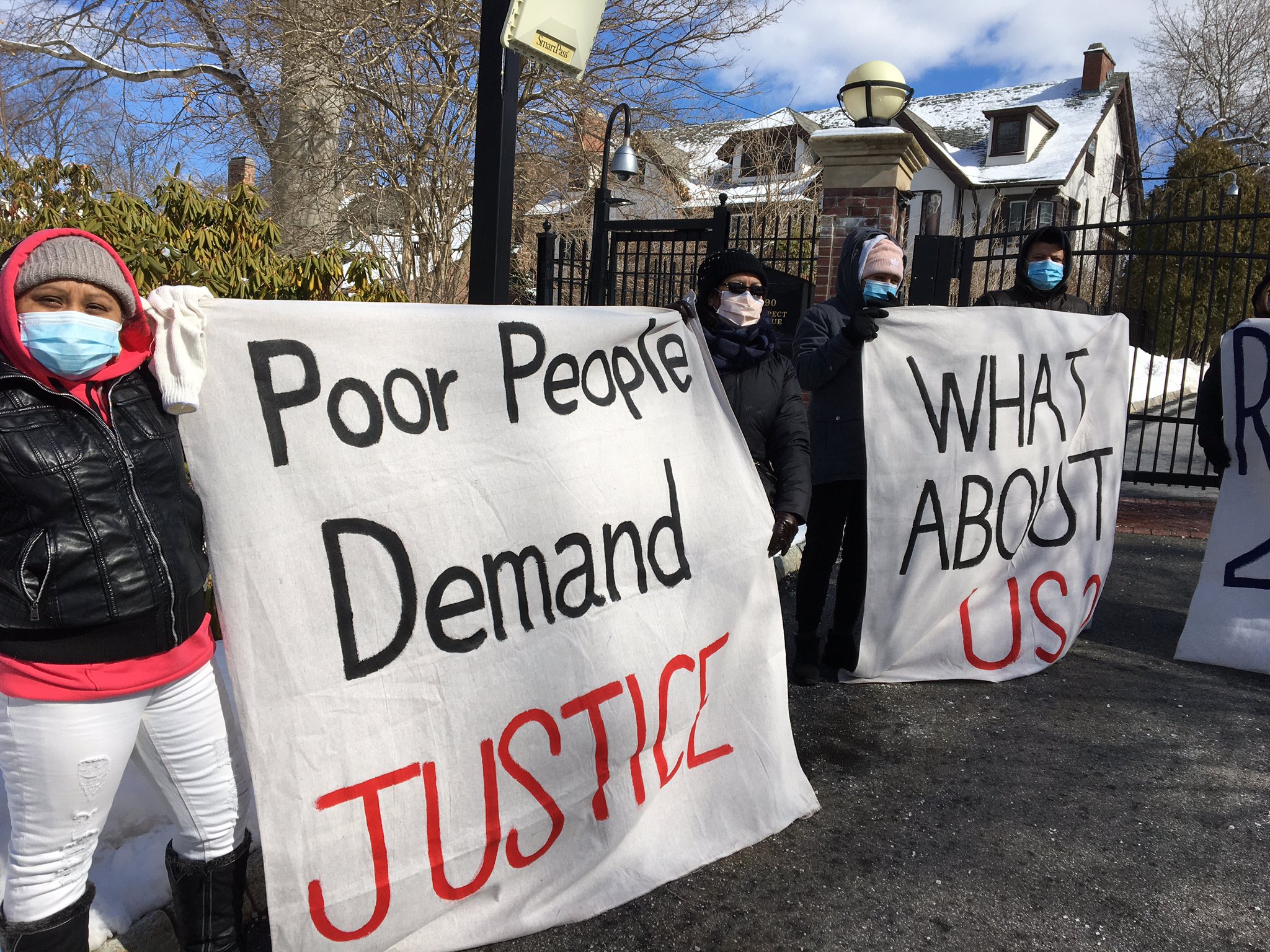
UNIDAD LATINA EN ACCIÓN CT
A rally titled “Recovery for All” is staged outside the Governor’s Residence
Open for business?
It’s unclear just how many companies have gone out of business in Connecticut since last March. The state’s business closure data is not meant to measure business levels.
However, the number of small businesses that are open is drastically down. In low-income neighborhoods, small businesses that are open now compared to last March is down by 37% compared to 34% in middle-class communities. This typically private financial transaction data collected by Harvard Economist Raj Chetty’s team shows no noticeable gains in businesses reopening since the vaccine rollout. The U.S. Census Bureau’s bi-weekly surveys of small business in Connecticut also indicates more companies each week are reducing their workers’ hours than increasing them.
Retail vacancy and foot-traffic data collected by some municipalities and local business organizations also offers some clues.
In downtown New Haven, businesses being able to partially reopen last June helped, but foot traffic has lingered at 65% below its pre-pandemic levels ever since. Several of the businesses didn’t survive, and by the fall, one out of every five storefronts downtown were vacant, according to the city’s deputy economic director.
“We did see an immediate bump in our pedestrian statistics — and then it plateaued, and that’s kind of where we’ve stayed,” said Win Davis, the executive director of New Haven’s Town Green District, which tracks foot traffic.
In downtown Bridgeport, one out of every eight ground floor businesses, which are most often retail establishments, were vacant before the pandemic. Now it is one-in-six.
Nationwide, retail foot traffic is down by nearly 60%, with cities seeing much sharper declines that suburban communities, according to Springboard, a company that measures pedestrian traffic by installing small electronic devices in communities around the country, including a handful in Connecticut. The firm’s research also shows that shoppers are more than twice as likely to shop at an outdoor shopping mall during the pandemic than a downtown area.
Some attribute the exponentially higher unemployment rates among city residents and low-income residents to the drop-off of retail and hospitality jobs that were once fueled by customers who are now working from their suburban homes. In Bridgeport and New Haven, about half of the pre-pandemic workforce commuted from the suburbs. In Hartford, two-thirds of commuters traveled from the surrounding towns.
“Places like Hartford were struggling before in terms of economics — and with people working from home, Hartford doesn’t work. Hartford’s economics are just not working,” said Johnson. Hartford — which had the second highest unemployment rate in the state with one out of every eight people out of work in January — is home to numerous state office buildings, and many state employees continue to work entirely from home. “A lot of our income comes from people driving in. … The minute we shut down businesses and state buildings and workplaces, you begin to see the real economy in Hartford.”
This downturn is showing up in the state’s unemployment numbers.
Each week, 2.5 times more newly unemployed workers are applying for the first time for benefits — 3,250 people last year compared to about 8,200 now. And four times as many people are requesting their unemployment benefits be extended another week — that’s 176,000 weekly claims now compared to 42,400 a week pre-pandemic.
Restaurant workers have seen the sharpest declines in the workforce, a population that tends to be low-income and disproportionately Latino, according to census data.
“I think that when large organizations in downtown New Haven bring their workforce back downtown, we will certainly see things improve,” said Davis, pointing out that City Hall and Yale employees are still mostly working remote. “A percentage of everybody’s workforce seems to be kind of missing from downtown so I think one of the things that will truly help us is when everyone is comfortable enough to come back to work.”
Connecticut has one of the highest rates of workers teleworking still. The U.S. Census Bureau reports that at least 46% of employees in Connecticut are teleworking — a rate that hasn’t budged since September, when the bureau first started tracking it. In Connecticut, high wage earners in March were teleworking an estimated 4 times the rate of low-wage workers.
A full return to the office is still a ways off for many businesses, however.
Chris DiPentima — the leader of the state’s largest business organization, the Connecticut Business & Industry Assocation — said in the upcoming months about 50% of businesses whose employers are working remotely are expected to return full time, 25% part-time, and the remainder will continue to work remotely.
“So a good portion will come back into the office, either full-time or at least a hybrid way. But, it’s still going to jeopardize the commercial real estate that we have. We don’t know for sure which businesses fully returned. We’re hearing some talking about July, others talking about September or October, so I don’t think we have a real good assessment of what that means to commercial real estate in our cities,” he said. “When we do reopen, we [need to to be] able to grow our cities, because the state will only be as successful as our cities. So that’s gonna be critical.”
A survey conducted by CBIA of 3,200 businesses throughout the state in January found that 24% were operating with reduced hours and capacity and 35% have laid off staff as a result of the downturn.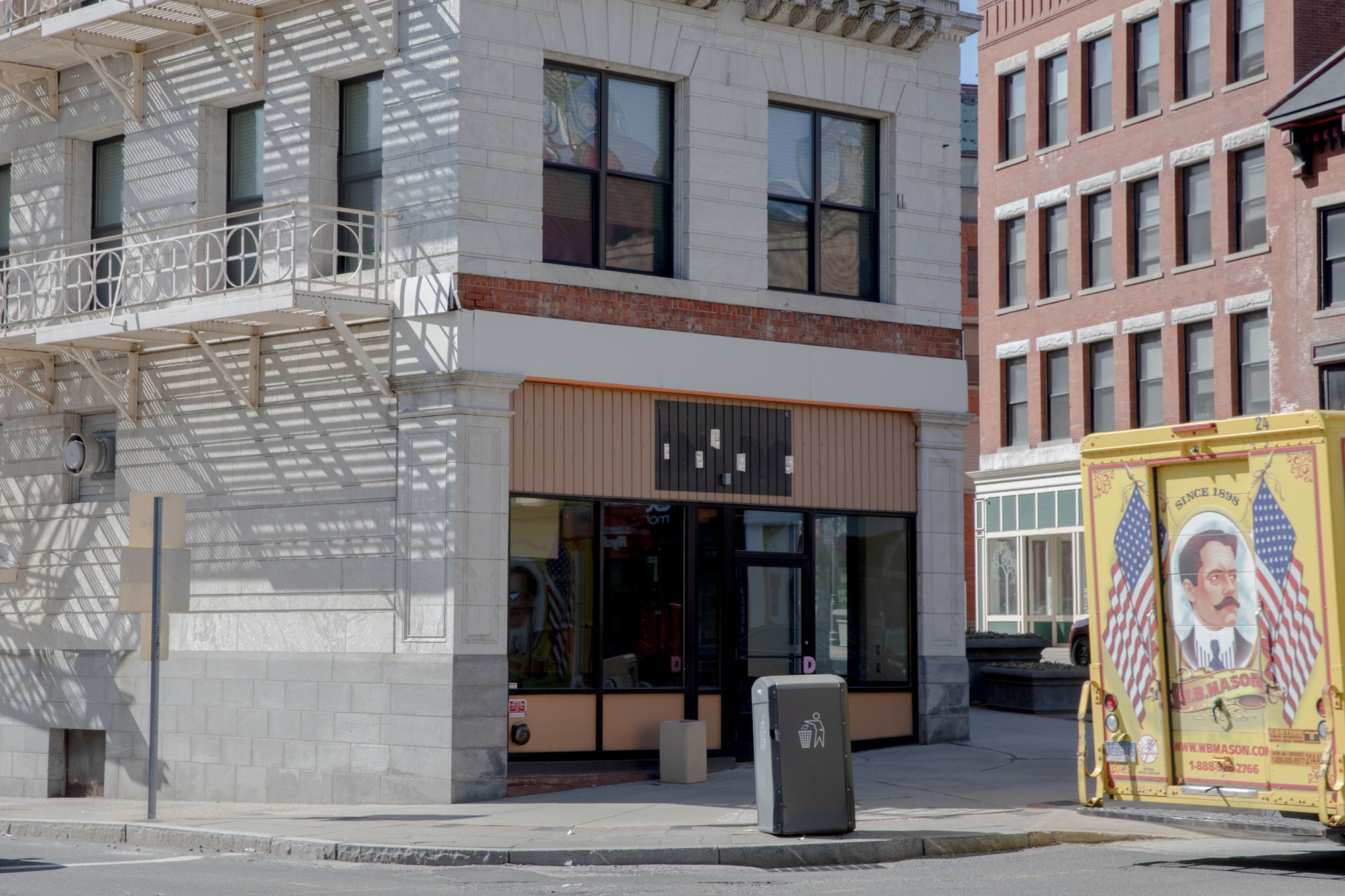
An empty storefront on South Main Street in Waterbury. It used to be a Dunkin Donuts.
In Bridgeport, the leader of the city’s downtown district said she has been told by several property owners that they are expecting most offices to return “somewhere around June.”
“That foot traffic is really important for many of our downtown businesses,” said Lauren Coakley Vincent, the presidents of the Bridgeport Downtown Special Service District. “We really look forward to the near future when, for example, bars are able to reopen and get back to kind of businesses normal and have daytime office workers return to their workplaces.”
In the meantime, the rate of vacant storefronts in Connecticut’s largest cities are higher than both the overall New England regional figure, as well as other downtown districts in the region.
“We thought at the beginning, ‘Oh, we can sustain. A month of this will be still a hit but we’ll make it through. And then as the pandemic raged on, by the summer we just, we couldn’t. We couldn’t go any further, unfortunately,” said Marcella Kovac about having to close her co-working spaces in Bridgeport and Southport. “It was, of course, emotional. We really put a lot of our own blood, sweat, and tears, especially early on. It was very much bootstrapped and then as the business started to grow we really had very high hopes for it to continue to help people wanting to set up shop in Bridgeport get their first step and we saw such a positive impact. … It was so sad to not only have to close the doors to Bridgeport, which we had grown for seven years, but also to sort of close the doors to that dream.”
The space remains vacant today.
A photo from the real estate listing where Kovac’s cospace company used to be filled before the pandemic touched down.
Who and where the pandemic is economically impacting is apparent to Glendowlyn Thames, chief operating officer of the state’s Department of Economic and Community Development. If employees start to return to their offices, it will have an impact.
“What will the environment look like in six months? Is it going to look like January 2020, or is it going to look like more of February 2021? And what are going to be those permanent changes as a result of COVID?” she said. “The pandemic significantly impacted low- to moderate-income workers and people in communities of color, and it exacerbated sharply the issues that were long standing — and now are glaring right in everybody’s consciousness. We’re really trying to focus on how do we use our resources wisely to really be targeted and intentional because we know where the pain is and where the bleeding is happening.”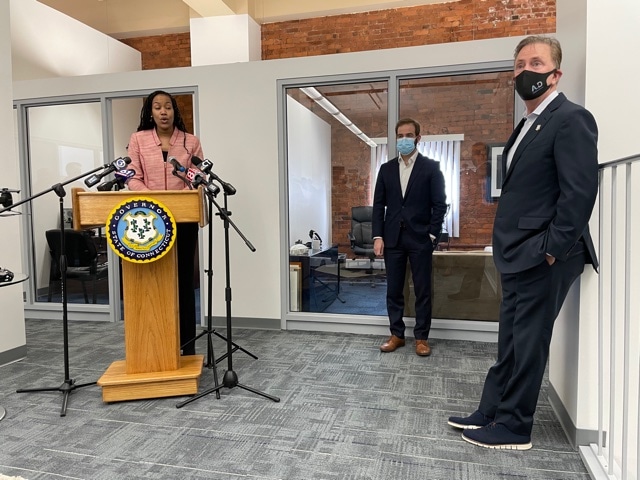
MARK PAZNIOKAS :: CTMIRROR.ORG
Gov. Ned Lamont, right, listens to Glendowlyn Thames of the Department of Economic and Community Development at an event meant to highlight Connecticut’s economy and migration into Connecticut. Center is Hartford Mayor Luke Bronin.
Labor-force drop outs
A host of reasons are keeping people home and unemployed, including child care challenges and health concerns.
In Connecticut, 150,000 students have not stepped into a classroom this school year — either because schools are not open or because their families are too worried about the virus to send them back — Gov. Lamont told business leaders earlier this month.
“Our job now is to get the kids who are reluctant back into school, just like their parents who are reluctant, to get them vaccinated,” said Lamont, a Democrat.
As more schools welcome students back full-time and the number of vaccinated adults grows, Lamont anticipates more people will return to work.
Pearson’s three sons and two daughters returned to school in New Haven last week ahead of her starting her new job.
‘They needed to get out of this hotel and see their friends and get their minds off of what’s going on here,” she said.
For Gina Pavao, the fact that Meriden offered her son and daughter a full return early in the school year meant she could return to work as a cashier at the Save-A-Lot convenience store in town. Her son and daughter missed their friends and their grades were plummeting as she struggled to help them do their work at home. She was also not getting as much in unemployment compensation as she would have earned working after the $600-a-week unemployment boost was scaled back to $300. The Federal Reserve estimated that even with the $600 boost, the wages of 16% of low-income workers still shrunk.
“I had to stay home and watch the kids, and it was a lot. It was a lot,” she said. “I went back to work when they went back to school.”
 Lauren Bernacchia, assistant principal, helps Alexandra Desjardin, 6, learn using a laptop at Roger Sherman Elementary School in Meriden.
Lauren Bernacchia, assistant principal, helps Alexandra Desjardin, 6, learn using a laptop at Roger Sherman Elementary School in Meriden.
But many have grown discouraged by the job market or don’t yet feel it’s safe enough to return.
The state’s 8.5% unemployment rate — which is twice as high as it was before the pandemic — doesn’t account for these labor-force drop outs. Participation in the workforce among those over age 16 dropped from 67% pre-pandemic to 60% in February.
There is limited financial help for some of those who don’t feel safe to return. In Connecticut, the state issued guidance July 31 informing those who are considered at “high risk for severe illness from COVID” that they can refuse an offer to return to work and still collect unemployment. However, that protection did not extend to those who may expose a high-risk family member to the virus by returning to work.
The U.S. Department of Labor, however, on Feb. 25, released guidance allowing those who “work at a worksite not in compliance with coronavirus health and safety standards” to become eligible for federal unemployment compensation.
“Until now, many workers have faced a devil’s bargain: risk coronavirus infection, or choose some level of safety and live without income support,” said Suzi Levine, the agency’s principal deputy assistant secretary of labor for employment and training. “Today’s guidance means more workers and families will be able to put food on their tables as our nation fights this virus, while we work to help millions of Americans return to good jobs.”
That hasn’t helped Pearson’s husband much. His application for unemployment was denied after he decided not to return to campus as a chef when students returned because he has a pre-existing condition. He’s challenging the denial, a process that typically takes months.
CT Mirror · Denitra Pearson on her family’s food diet while they live out of a hotel
So, for now, the family is living off the $1,070 Denitra receives in unemployment compensation each month. After losing her job, she also applied for state aid to help her pay for food. She gets $500 a month.
“But how does that help when you can’t cook. I’m in a hotel with a fridge and a microwave,” she said.
The unemployment money she got last Monday was gone by Wednesday, she said.
Better days ahead?
Despite employment rates among bottom wage workers showing almost no signs of improvement for months, state officials and the business lobby are hopeful the state is about to turn the corner.
Driving that confidence are the thousands of the people getting COVID vaccines each day, more schools reopening for full-time instruction, and hopes that there is a strong demand from pent up residents to eat out, shop, and travel. A massive third round of federal relief aimed at boosting the recovery will also route more aid to struggling businesses, entertainment venues, and residents to infuse money into the economy.
“Our economy is like a coiled spring. I think it could snap back and snap back pretty quickly,” Lamont told business leaders earlier this month. “I think our budget is strong. I think we’re going to make a big effort to get people back to work.”
“We’re in the ninth inning of all this. I’ll say the light at the end of the tunnel, we can really see it now,” said DiPentima, the leader of the state’s business coalition. “Those businesses that are in that struggling bucket only need to get through another one or two months where we’re almost back to normal, if you will. I think the [federal recovery package] will take them there.”
But Lamont, a baseball fan, reminds people that a lot of games are lost in the ninth inning.
“If we stick to our strategy, we’re going to find June is a pretty nice month,” he said.
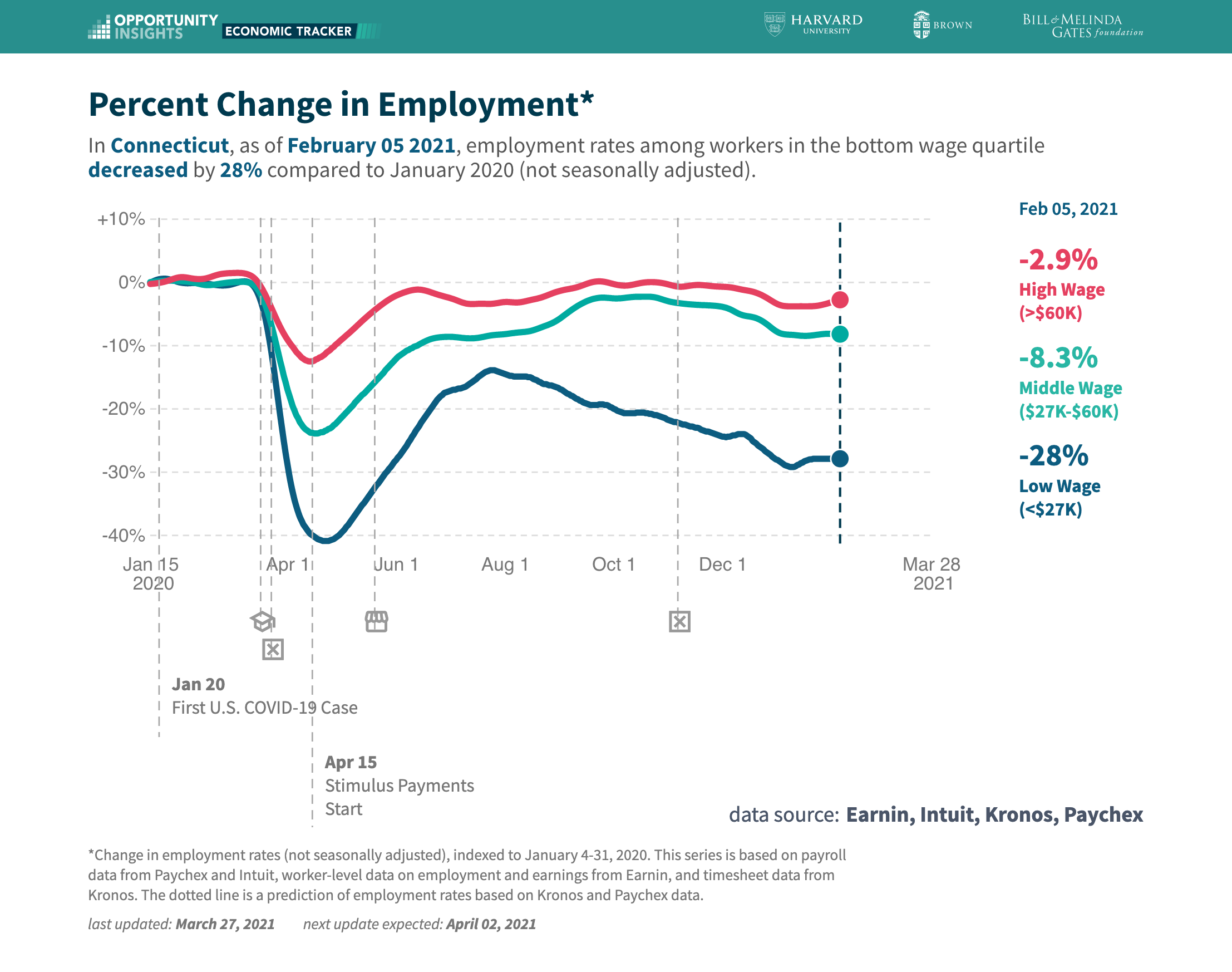
Some economists, however, warn it will take years to return to pre-pandemic job levels.
Don Klepper Smith, an economist from DataCore Partners who was chief economic adviser in the late 2000s to former Gov. M. Jodi Rell, said the combination of federal stimulus dollars and wealthy residents, who weren’t financially impacted as harshly as others, is artificially rightsizing the state’s fiscal coffers and somewhat masking the structural weakness of the state’s economy. Growing back the lower- and mid-wage jobs will be critical to ensuring a healthy economy, he said.
“My sense here is it’s going to be a long haul for Connecticut,” he said. “The economy is like a spring coil? What a nice idea and something I could understand coming out of the mouth of the governor of Connecticut. I think I see that as more rhetoric than factually based. He’s not looking at the same data I am.”
“… Saying the Connecticut economy is ‘poised like a spring’ is like saying the Red Sox are poised to score six runs in the third inning of a nine inning game against the Yankees,” Klepper Smith added. “That’s the very nature of short-term thinking and it’s myopic. You need to look at the long-term for a true picture of economic health. Short-term trends, by definition, are very volatile.”
University of Connecticut Economist Fred Carstensen also isn’t optimistic.
“Connecticut’s economy is in a very, very deep hole. It is the worst performing state economy in the nation, by a WIDE margin,” he posted March 27 on LinkedIn. “When will the challenge of climbing out get serious, sustained attention in Hartford?”
There are some glimmers of hope in the typically private industry data being tracked by the team at Harvard.
The amount of time people are spending out of their homes at grocery stores, retail stores, and in transit are on the rise for the last month, as is business revenue from companies located in both low- and middle-income neighborhoods, but all of these markers are still below pre-pandemic levels. Gross domestic product also increased at one of the fastest rates during the last three months of last year, though the state’s 4.1% drop in GDP throughout 2020 was one of the largest in the country.
Monthly job postings are down 2%, but those which require minimal education are significantly up.
For those low-wage workers who want to go back to school so they can get a higher paying job, but can’t afford child care to do so [the state’s child care subsidy program requires people to have a job to qualify], the state’s Office of Early Childhood has launched a pilot program at a handful of community colleges to offer childcare while parents are in class. The agency is looking it to expand it even further, said Commissioner Beth Bye.
“You know you can’t get a job if you need childcare, and you can’t get childcare with that job. And so we’re really looking at how we can untangle those two, to help more people be able to get out in the workforce,” said Bye. “Childcare and transportation are the two biggest barriers for people getting degrees. If you can’t get a better job, you can’t move forward.”
<html>
<head>
<meta http-equiv="Content-Type" content="text/html; charset=utf-8">
<title>Map template</title>
<meta name="viewport" content="width=device-width">
<script src="//ajax.googleapis.com/ajax/libs/jquery/1.11.0/jquery.min.js"></script>
<link rel=StyleSheet href="style.css" type="text/css">
<link rel="stylesheet" href="leaflet.css" />
<script src="leaflet.js"></script>
<!--[if lte IE 8]> <link rel=StyleSheet href="//projects.ctmirror.org/libs/leaflet/leaflet.ie.css" type="text/css"> <![endif]-->
<script type="text/javascript" src="functions.js"></script>
<script type="text/javascript" src="init.js"></script>
<link rel=StyleSheet href="//projects.ctmirror.org/libs/universal.css" type="text/css">
</head>
<body>
<div class="interactiveContainer">
<div class="graphicHeader" id="headermain"></div>
<div class="explainer" id="headersub"></div>
<div class="toolbar">
</div>
<div class="mapContainer">
<div id="map"></div>
<div class="infobox"></div>
<div class="legend">
<div class="legendKicker"></div>
<div class="legendColorBox"></div>
<div class="legendNumberBox">
<div class="legendNumber" id="legend1"></div>
<div class="legendNumber" id="legend2"></div>
<div class="legendNumber" id="legend3"></div>
<div class="legendNumber" id="legend4"></div>
<div class="legendNumber" id="legend5"></div>
</div>
</div>
</div>
<div class="sourceline" id="headersource"></div>
<div class="smallByline" id="headerbyline"></div>
</div>
</body>
</html>The federal recovery package has also sent Connecticut $120 million to boost child care programs that have been hit fiscally hard during the pandemic. This will help ensure there is child care available for parents returning to work, as well as retain jobs for day care workers.
The Department of Labor is bullish on the economy in the coming months.
“There’s no question that the end of the pandemic is going to lead to strong economic growth due to what economists call pent up demand. We know that in 2020 people did not travel. They did not go out to dinner. They even delayed their elective surgeries and other medical procedures. All of that activity should occur once the pandemic is over,” said Patrick Flerty, an economist at the Connecticut Department of Labor, in January. “The solution to the public health crisis will lead to strong economic growth.”
But many, including the chairman of the legislature’s Black and Puerto Rican Caucus, are worried certain residents will be left behind.
“We’re just at the tip of the iceberg with recovery. Unemployment is still high. There’s still a lot of people that are unemployed and you can see that the people are just itching to get out and do something and trying to get a job,” said state Rep. Geraldo Reyes, a Democrat from Waterbury, a community with one of the highest unemployment rates with one-in-eight workers unemployed.
“We don’t count just a recovery on only certain communities. As we have recovery statewide, it needs to include everybody. And we’re not there yet. We’re not there yet. So is the state doing enough? That answer is still in process.”
Article from the CT Mirror
